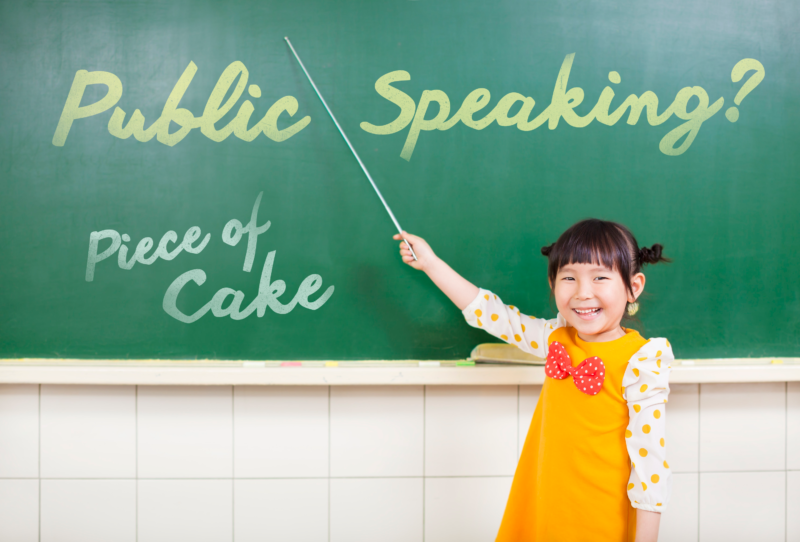Public speaking doesn’t come naturally to most people and for some, it’s petrifying. The fear of public speaking is so pervasive that organizations like Toastmasters are dedicated to helping adults feel comfortable speaking in front of a crowd. But, this fear is often an issue that starts long before adulthood. It begins in school, where students are asked to formally present to their classmates, informally share ideas in small groups, and participate in whole-class discussion.
This isn’t something students can avoid, either. Public speaking skills are important for college and career success and they are also a critical requirement of the Common Core State Standards in ELA for students to master before graduation.
So how can you support your students to be more comfortable and proficient public speakers? Here’s a list of quick tips you can implement in your classroom to bolster students’ speaking confidence:
1. Establish Routines Early
Starting in kindergarten, students are expected to: Speak audibly and express thoughts, feelings, and ideas clearly as per the Common Core. Most teachers accomplish this by asking students about something they are interested in, often as part of Show and Tell. While this is a good start, by adding just a few routines, teachers can ingrain essential public speaking skills into their students early on. Ask students to stand as they speak, articulate their words, speak loudly, and use complete sentences when participating in class. These small reinforcements will establish strong habits and set them on the path to being comfortable, articulate public speakers.
2. Set Performance Guidelines
Giving a presentation is about more than just delivering strong content. Along with guidelines about what you expect your students to include in their presentations, also let them know what you will be looking for in terms of their “performance.” Share your grading rubric with your class before they plan their presentations and emphasize exactly what you will be evaluating. Keep in mind that you don’t want to overwhelm your students, as they will likely already be nervous about speaking in front of a crowd. So, start small. For instance, early in the year, students may be less comfortable speaking, so you may want to focus on how clearly and slowly they speak. For their next presentation, you can concentrate on how well they make eye contact with their audience, etc. As your students master one aspect of public speaking, you can add another important skill to the rubric.
3. Practice Critical Listening
In order to be good speakers, students have to be good listeners. Provide students with listening guides to follow as others present. For lower-grade levels, this can be as simple as a checklist. For higher-grade levels, you can provide them with detailed listening rubrics, which will help them assess things like the speaker’s posture and body language, volume and inflection, clarity of the information being presented, and how the speaker responds to questions from the audience. By learning what to look for in others’ presentations, students will gain a better understanding of how their own presentations should look and sound.
4. Add a Face to Great Public Speaking
Search for age-appropriate exemplars (videos, podcasts, recordings) of good public speaking and show them to your students. If you can’t find one, make one yourself or solicit a student volunteer to act as your model. Once students have seen the example, engage them in a discussion about what the speaker did well.
5. Incorporate Visuals
Encouraging your students to include visual resources when they present, adds flare to the presentation and gives the audience something to look at other than the presenter. Students will feel much less nervous if the class has something else to focus on and visuals can provide something for older students to reference if they are trying not to read from a script. As an added bonus, incorporating various media into their presentations will help your students master one of the requirements within the CCSS Speaking and Listening Anchor Standards.
Students of all grade levels can use media in their presentations. For children in lower-grades, you can encourage them to include drawings or other visuals on poster board, collages, or dioramas. For children in fifth grade and up, the CCSS expect that multimedia components become part of presentations. This doesn’t mean you have to start with the PowerPoint lessons yet. There are some pretty cool (and free) digital resources, including Prezi and Glogster.
6. Practice Makes Perfect
Some students thrive as the center of attention. Others are uneasy and have to be coaxed to perform. To ease the tension of the latter, make practicing the presentation part of the assignment. It could be at home with parents, in front of a video camera or mirror, with a partner from class, or with you after school. The more students hear their own voices and presentations, the less panicked they will feel when it’s time for the real thing.
7. Wrap it up with a Conference
If time allows, attempt to conference with each student after his or her presentation. Let them know what they did especially well and give actionable items they can use to improve their presentation skills. Conferencing takes time, but it will help you pinpoint your students’ concerns and setbacks and most importantly, it will let them know you care.






